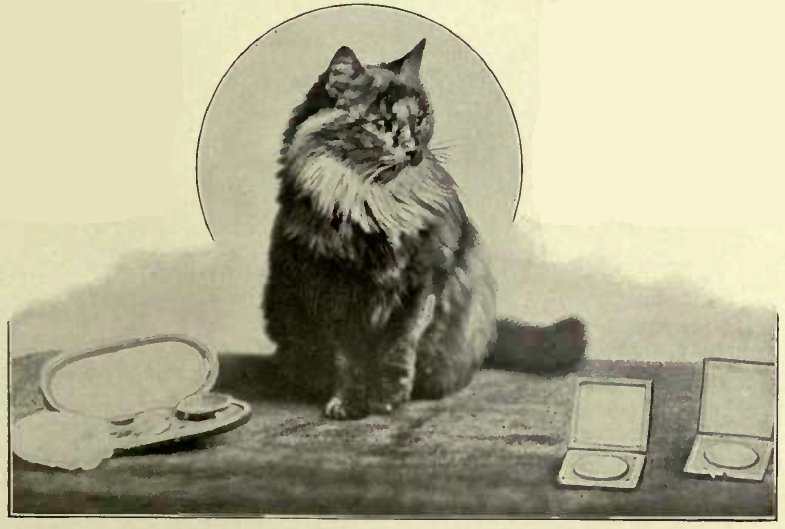XVII. TORTOISESHELL PERSIANS
Texte und Bilder aus “THE BOOK OF THE CAT” von Frances Simpson aus dem Jahre 1903
THE BOOK OF THE CAT
CHAPTER XVII.
TORTOISESHELL PERSIANS
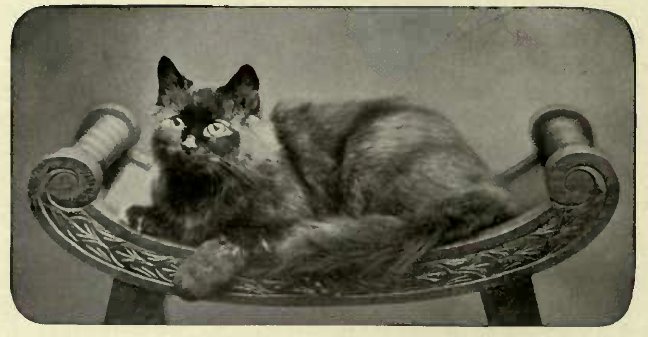
MANY years ago, when I first took up the cat iancy, I used to think tor-toiseshells ugly and commonplace, and I am afraid even now I have not that admiration for the breed which I feel a really good specimen of this variety ought to inspire. To begin with, it is seldom that a true type of long-haired tortoiseshell is seen or exhibited, and perhaps this may account for the breed being so much neglected. They are not taking-looking cats, and make a poor show in the pen. I have often remarked, however, that this is a favourite breed with the sterner sex, and that our professional men judges will almost invariably pick out a tortoiseshell when judging an ” any-other colour ” class, and give it some mark of distinction. This may be accounted for by the fact that, of all varieties, a really good tortoiseshell is most difficult to breed, and therefore any specimen approaching perfection should be encouraged. There are splashed and sable tortoiseshells. and tortoiseshell tabbies, all handsome cats of their kind, but not the genuine article. Real tortoiseshells may be called tricolour cats, for they should bear three colours, like a tortoiseshell comb, on their bodies, namely black, red, and yellow, in distinct patches or blotches, solid in colour and well broken up, with no trace of stripes, bars, or tabby markings. A brindling effect is to be avoided, and a white spot on chin is a great blemish. It is most undesirable that the black should predominate, in which case the specimen will lack brilliancy. The three colours should, if possible, be pretty evenly distributed over the body, legs, and tail, and should not run into each other. The red and yellow may preponderate over the black with good effect. A blaze, so called, up the face is considered correct, and this should be of the red or yellow, and in a straight line from the nose upwards. This is a very distinctive feature in the breed, and one that judges will look for in a good show specimen. It is incorrect for the tail to be in any way ringed with the colours. The texture of the coat is often coarser and more hairy in this breed, and it is not usually so long and flowing as in other varieties of Persian cats. There is no difference of opinion as to the correct colour for the eyes of tortoiseshells. They should be a bright golden or orange, and these seem in perfect harmony with the colouring of the coat. Tortoiseshells never attain any great size, and may be called a small breed of Persian cats. I give the list of points as drawn up by the specialist society :—
TORTOISESHELL.
Colour and marking. —The three colours—black, orange, and yellow—to be well broken and as bright and well denned as possible; free from tabby markings, no white. 30.
Coat. —To be silky, very long, and fluffy. 20.
Size and shape. —To be large—not coarse, but massive, with plenty of bone and substance ; short legs. 25.
Head. —To be round and broad, with short nose, ears small and well opened. 15.
Eyes. —To be large and full, and bright orange or hazel in colour. 5.
Condition. —10.
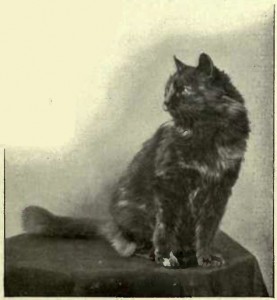
They are quite one of the most interesting from which to breed, and experiments can be tried successfully in crossing a tortoiseshell queen with black, cream, orange, and blue cats. The litters will often be a study in variety. I have known one family to consist of a black, a white, a cream, an orange, and a blue ! The owner of such a litter would have something to suit all comers. A really good tortoiseshell queen may, therefore, be considered a valuable property. And what of a tortoiseshell torn ? A mine of wealth would such a possession be to any fancier. Among short-haired cats a tortoiseshell torn is a rare animal, but I do not think a long-haired specimen has ever been seen or heard of. Several experiments have been tried, but it remains for some skilful and scientific breeder to solve the problem of the manner and means to be employed to produce males of this breed. The classification at our smaller shows for tortoise-shells is generally of a meagre and discouraging description. There are so few specimens that executives of shows fight shy of giving a class for even tortoiseshell and tortoiseshcll-and-white together. So tortoiseshells are mixed up in the ” any other colour ” class, and therefore this breed can seldom, if ever, be really judged on its own merits, or comparisons made between the different specimens that are exhibited. At our largest shows there are classes provided, which, however, are poorly filled. 14
Tortoiseshells may be said to have had no past. There are no celebrities in feline history save and except ” Queen Elizabeth,” and not only was she the finest of her breed, but she also made her name famous by severely injuring Mr. W. R. Hawkins, who was examining her when making his awards; and I have good reason—or rather bad reason—for recollecting her, on account of her fixing her teeth into my hand when I was removing her from her basket to pen her at the Westminster show in 1899. It seems that she had a great objection to travelling, and resented making an exhibition of herself in public ! She was a grand specimen, however, and, besides always carrying off highest honours herself, she was the mother of many prize-winning orange and tortoiseshell cats, amongst others ” Prince Charlie,” “Prince Lyne,” and ” Mattie.” I have failed to obtain a photograph of this celebrated cat; and, even had I succeeded, a tortoiseshell makes a tetribly poor picture when reproduced in photography, for the reason that the yellow comes out only fairly light, the orange appearing as dark as the black patches.
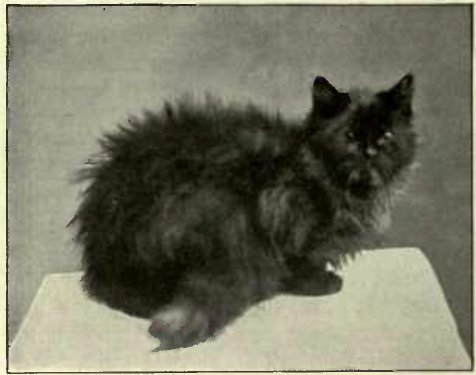
Miss H. Cochran had a dear old pet puss called “Brunette,” a dark tortoiseshell, and from her were bred some of the first cream females ever exhibited. The Hon. Mrs. McLaren M orrison has a good tortoiseshell, ” Curiosity ” by name. The best three specimens now before the public are Dr. Roper’s ” Dainty Diana,” Miss M. Beal’s ” Pansy,” Miss Kate Sangster’s ” Royal Yum Yum,” and Mrs. Bignell’s ” Topsy of Merevale.” As regards the last-named, Mrs. Bignell has kindly supplied me with particulars of ” Topsy’s” litters when mated with different-coloured cats. ” Topsy’s ” first litter in 1896, when mated to the ” Duke of Kent ” (a blue), was two creams and two smokes. When mated to ” Johnnie Fawe ” (a black) her kittens were all of the father’s dusky hue. Again, when crossed with another blue m’ale her litter consisted of two orange males and a tortoiseshell female, and again to the same cat one black male and two orange males. “Topsy” is a noted prize-winner, and one of her smoke children, ” Lucy Claire,” went out to Chicago, and is considered the finest smoke specimen in the American fancy. Dr. Roper’s “Dainty Diana ” is one of the best-known tortoiseshells, and her colouring as good as any exhibited; she is the mother of many winners. Miss Kate Sangster, who is a great admirer of this breed, writes : ” My ‘ Champion Royal Yum Yum ‘ was bred from a black and a tortoise-shell, and her grandsire was a cream. She is over .seven years old, and has had twenty-two kittens, namely, five cream, five blue, five orange, four black, and three tortoiseshell.”
Miss Mildred Beal, who with her sister is so well known in connection with cream and orange cats, is also the owner of some fine tortoiseshells. ” Wallflower ” (well so named) is the mother of a noted prize-winning cream called ” Sunlocks.” ” Pansy,” Miss M. Beal’s special pet, is a well-known tortoiseshell. ” Snapdragon,” another prize-winner, was ex-‘ported to America, where quite a number of the Romaldkirk cats have found their home. We need a few more enthusiastic admirers of tortoiseshells like Miss M. Beal to take up this rather despised breed and follow in her footsteps. Some notes by the owner of ” Pansy ” will be of interest :—
” Even fanciers who will go into raptures over the blue, orange, cream, or silver members of the establishment have no admiration to spare for a tortoiseshell, however striking its record of prizes may be ; and yet to those who breed and understand them there is something very fascinating about these quaint creatures, though the taste for them is certainly an acquired one.
” Among non-catty people great ignorance prevails as to what colour a tortoiseshell cat really is. Many people, if asked to describe a tortoiseshell cat. would say that it was a sort of sandy colour all over ; others imagine that the ‘ chintz’ cat, as it is called in the North— white with black and red patches—has a right to the name. So let it be said at once that three colours, namely, orange, yellow, and black, and these only, enter into the composition of the true tortoiseshell. There must be no white, neither should there be any trace of tabby markings, though this is very difficult to attain. The three colours should be patched or ‘ broken ‘ all over the cat, and the more distinct each separate colour is in these patches the better. Brilliancy of colour is another point which breeders have to consider ; many tortoiseshells have far too large a proportion of black in their colouring, which gives them a dingy and uninteresting appearance, and is sure to go against them in the show pen. The eyes should be orange, and in other points, such as shape, head, and texture of coat, the standard is the same as for the other varieties of long-haired cats.
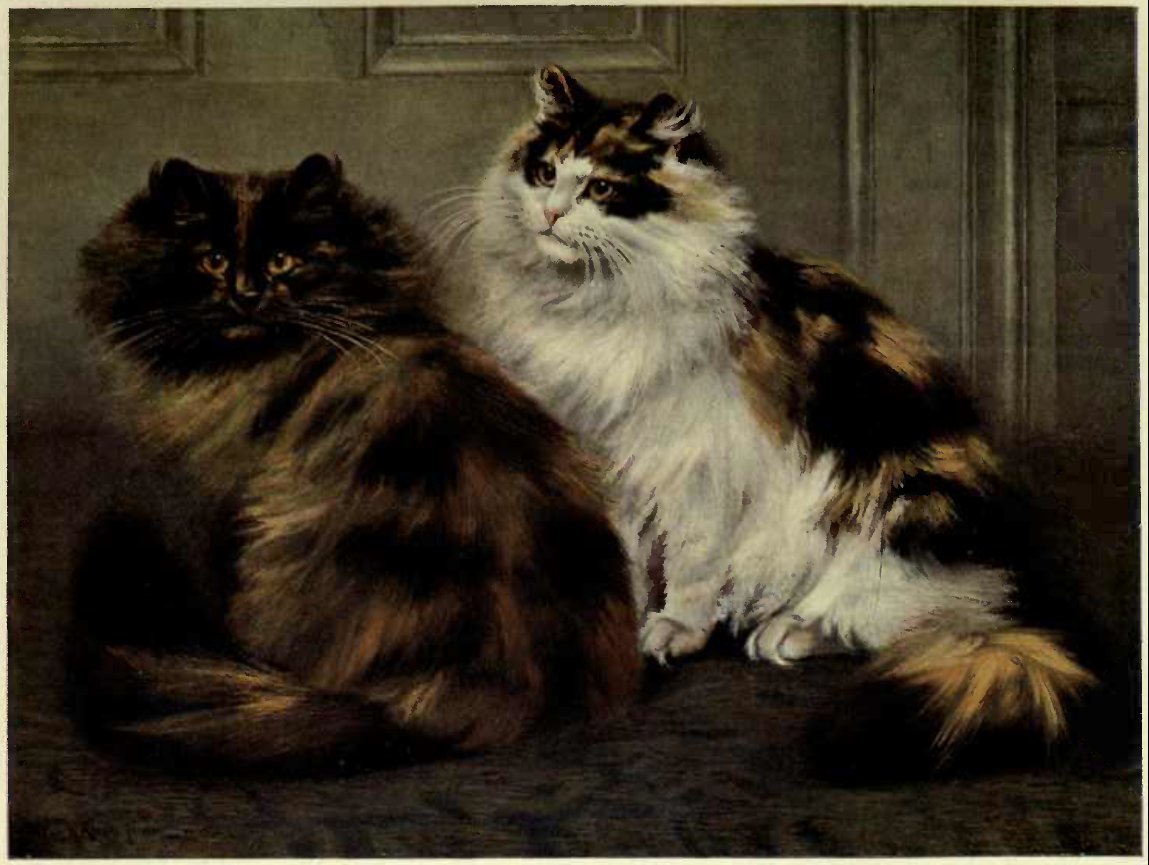
” One curious fact in connection with longhaired tortoiseshells, which is well known to fanciers, may be mentioned, namely, the non-existence of the male sex. Among short-haired tortoiseshells toms are exceedingly rare, though one or two do exist ; but an adult longhaired male appears to be absolutely unheard of. The writer knows of one male kitten born some years ago, but it was either born dead or died in very early infancy. Darwin’s theory that the orange torn and tortoiseshell queen were originally the male and female of the same variety is borne out by the fact that until recently orange females were also rare. Of late years a good many of these have been bred and reared, and therefore, if the Darwinian theory be correct, it seems hard to believe that the tortoiseshell torn must be regarded as unattainable. If the difficulty has been successfully overcome in the one case, why not in the other ? Breeding with this object in view is very slow work, for some tortoiseshell queens will produce litter after litter without a single kitten of their own colour, and a family consisting entirely of tortoise-shells would be as welcome as it is rare. But it would be a pity to despair of breeding the long looked for torn ; if he ever does make his appearance, he will be hailed with sufficient interest to gratify any quantity of feline vanity.
” At present, breeders hardly seem to recognise the great value of a tortoiseshell queen for breeding almost any variety of self-coloured cat. If the queen is mated to an orange, a cream, or a blue torn, she will be very likely to produce at least one or two really good specimens of the same colour as the sire, and sometimes a far larger proportion of the litter will ‘ favour’ him. Much, of course, depends upon how the queBn herself is bred, and this no doubt accounts for disappointment in some cases.
” Tortoiseshells compare very favourably with the other varieties of long-haired cats in the matter of intelligence. The writer knows one which enjoys the well-earned reputation of being the cleverest thief in the cattery. Nothing is safe from her nimble paws ; she has often been known to remove the lid from the saucepan in which the meat for the cattery supper had been placed, and make off with the contents ; and if the cook’s back should be turned for only half a minute, woe to tomorrow’s dinner or to anything else tempting which may chance to be within reach !
; ‘ Though tortoiseshells may be distinguished for brains, some of them certainly fail considerably in temper. They seem to find it most difficult to keep the peace with the other members of the cattery. I sincerely hope thisbreedwill receive more attention from fanciers in the future.
